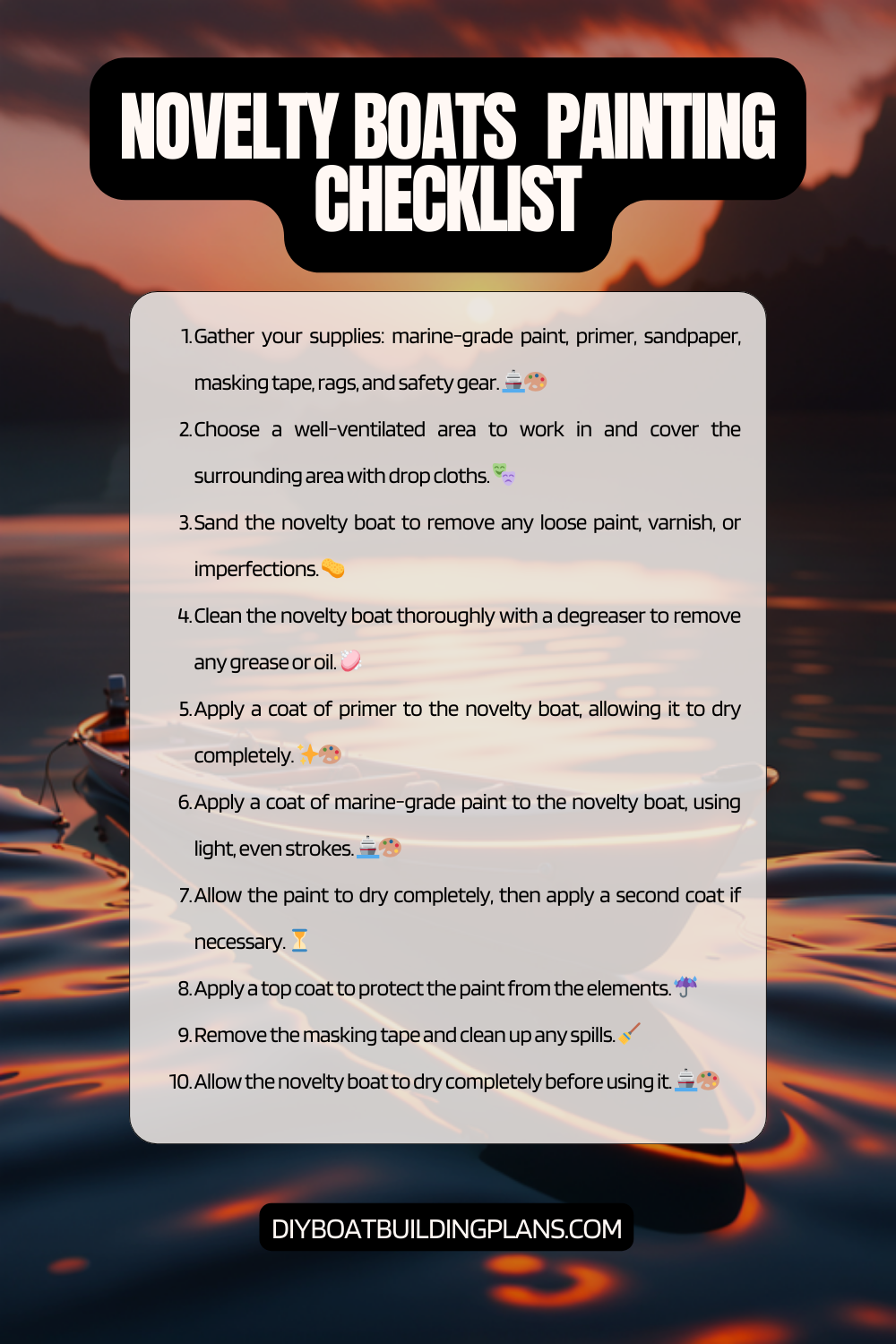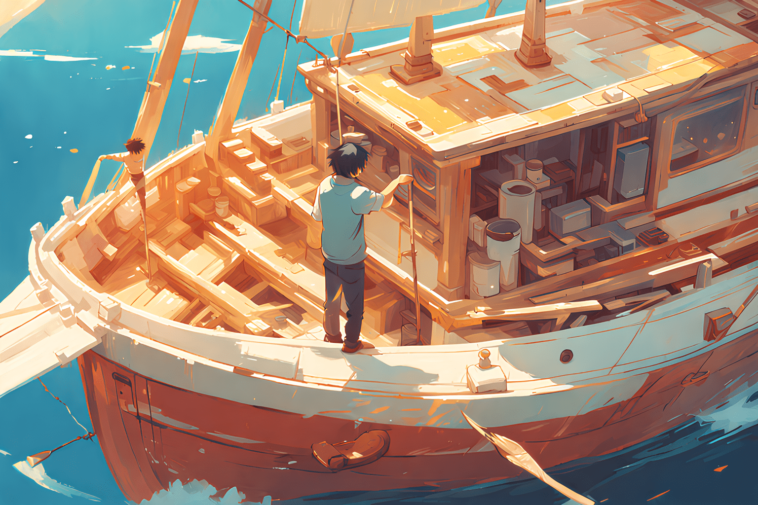Overview of Novelty Boat Painting Tips
Novelty boat painting is a unique and creative way to personalize your boat and make it stand out from the crowd. It involves painting your boat in a design or pattern that reflects your personality or interests. Whether you choose bold stripes, intricate patterns, or even a custom logo, novelty boat painting allows you to make a statement on the water.
The benefits of painting your boat in a unique way are numerous. Firstly, it adds a touch of individuality to your vessel, making it easily recognizable and memorable. This can be particularly useful in crowded marinas or when meeting up with friends on the water. Additionally, novelty boat painting can increase the resale value of your boat, as it sets it apart from similar models on the market. Lastly, it provides an opportunity for self-expression and creativity, allowing you to showcase your personal style and taste.
Key Takeaways
- Choosing the right paint is crucial for a successful novelty boat painting project.
- Proper preparation of the boat surface is essential for a smooth and long-lasting finish.
- Stripes and patterns can be achieved with masking tape and careful planning.
- Custom logos and designs can be created with stencils or freehand painting.
- Regular maintenance and care will help preserve the painted finish of your boat.

Importance of Choosing the Right Paint
Choosing the right paint for your boat is crucial to ensure a long-lasting and high-quality finish. There are different types of paint available, each with its own properties and suitability for different surfaces. Two common types of paint used for boat painting are enamel and polyurethane.
Enamel paint is known for its durability and resistance to fading, making it a popular choice for boat owners. It provides a glossy finish and is relatively easy to apply. On the other hand, polyurethane paint offers superior UV resistance and is highly durable, making it ideal for boats that are exposed to harsh weather conditions.
When choosing paint for your boat, there are several factors to consider. Firstly, you need to assess the condition of your boat’s surface. If there are any existing coatings or damages, you may need to choose a specific type of paint that can adhere properly or repair any imperfections. Additionally, consider the color options available and how they will complement your chosen design. Lastly, take into account the environmental impact of the paint and opt for eco-friendly options whenever possible.
Preparing Your Boat for Painting
Before you can start painting your boat, it is essential to properly prepare the surface. This involves cleaning and sanding the boat to ensure a smooth and even finish. Begin by washing the boat with a mild detergent to remove any dirt, grime, or salt residue. Use a soft brush or sponge to scrub the surface gently, paying attention to hard-to-reach areas.
Once the boat is clean, it’s time to sand the surface. This step helps to remove any existing coatings, roughen up the surface for better paint adhesion, and smooth out any imperfections. Start with a coarse-grit sandpaper and gradually move to finer grits until the surface feels smooth to the touch.
After sanding, inspect the boat for any damages such as scratches, dents, or holes. Repair these areas using an appropriate filler or epoxy compound. Once the repairs are complete, apply a primer to create a smooth and even base for the paint. The primer helps the paint adhere better and improves its durability.
Choosing a Design for Your Boat
| Design Considerations | Factors to Consider |
| Intended Use | Recreational, Fishing, Racing, etc. |
| Size | Length, Beam, Draft |
| Material | Wood, Fiberglass, Aluminum, Steel |
| Hull Type | Displacement, Planing, Catamaran, Trimaran |
| Power Source | Outboard, Inboard, Electric, Sail |
| Features | Cabin, Head, Galley, Cockpit, Swim Platform |
| Cost | Initial, Maintenance, Fuel, Storage |
Choosing a design for your boat is an exciting part of the novelty boat painting process. There are countless sources of inspiration available, from nature and wildlife to geometric patterns and abstract art. Consider your personal interests, hobbies, or favorite colors when selecting a design that resonates with you.
When choosing a design, it’s important to consider factors such as the size and shape of your boat. Some designs may look better on larger vessels, while others may be more suitable for smaller boats. Additionally, think about how the design will flow with the lines and curves of your boat’s hull.
Another factor to consider is whether you want a design that is timeless or one that reflects current trends. While trendy designs can be eye-catching and fashionable, they may become outdated over time. On the other hand, timeless designs, such as classic stripes or nautical themes, can maintain their appeal for years to come.
Tools and Materials You Will Need
To successfully paint your boat, you will need a variety of tools and materials. Here is a list of the essentials:
1. Paintbrushes and rollers: Choose high-quality brushes and rollers suitable for the type of paint you are using. Different sizes will be needed for different areas of the boat.
2. Paint trays: These are used to hold the paint and make it easier to load your brush or roller.
3. Sandpaper: Various grits of sandpaper will be required for surface preparation and smoothing out imperfections.
4. Masking tape: Use masking tape to create clean lines and protect areas that you don’t want to paint.
5. Primer: Select a primer that is compatible with your chosen paint type and suitable for the boat’s surface material.
6. Paint: Choose high-quality marine-grade paint that is specifically formulated for boats and provides excellent durability and UV resistance.
7. Clear coat: A clear coat is applied as a final protective layer to enhance the shine and longevity of the paint job.
Tips for Painting Stripes and Patterns
Creating straight lines and patterns on your boat requires some skill and technique. Here are a few tips to help you achieve professional-looking results:
1. Measure and mark: Use a measuring tape and pencil to mark the desired positions of your stripes or patterns before painting. This will ensure accuracy and consistency throughout the process.
2. Use masking tape: Apply masking tape along the marked lines to create clean edges. Press down firmly to prevent paint bleed.
3. Paint in thin layers: Instead of applying thick coats of paint, opt for multiple thin layers. This helps prevent drips, allows for better control, and ensures even coverage.
4. Remove masking tape carefully: Once the paint is dry to the touch, gently remove the masking tape at a 45-degree angle to avoid pulling off any paint.
5. Practice on a test surface: If you’re unsure about your painting skills or the design you’ve chosen, practice on a small test surface before tackling your boat. This will give you a chance to refine your technique and make any necessary adjustments.
Creating a Custom Logo or Design
If you want to take your novelty boat painting to the next level, consider creating a custom logo or design. This allows you to showcase your creativity and make a truly unique statement on the water. Here are the steps to create a custom design:
1. Brainstorm ideas: Start by brainstorming ideas for your custom design. Consider elements that are meaningful to you, such as symbols, images, or text.
2. Sketch your design: Use pencil and paper to sketch out your design concept. This will help you visualize how it will look on your boat and make any necessary adjustments.
3. Seek professional help: If you’re not confident in your artistic abilities, consider hiring a professional graphic designer or artist to bring your design to life. They can help refine your concept and create a digital version suitable for painting.
4. Transfer the design: Once you have a finalized design, transfer it onto your boat using transfer paper or stencils. This will ensure accuracy and save time during the painting process.
5. Paint with precision: Take your time when painting the custom design, paying attention to detail and using small brushes for intricate areas. Follow the same techniques mentioned earlier for creating clean lines and patterns.
Adding Text and Graphics to Your Boat
In addition to stripes and patterns, adding text and graphics can further enhance the uniqueness of your painted boat. Whether it’s a boat name, registration numbers, or decorative graphics, here are some tips for achieving professional results:
1. Choose legible fonts: When selecting fonts for text, opt for ones that are easy to read from a distance. Avoid overly decorative or elaborate fonts that may be difficult to decipher.
2. Use stencils or vinyl lettering: To ensure precise lettering, consider using stencils or vinyl lettering. These tools make it easier to achieve consistent spacing and clean edges.
3. Consider color contrast: Ensure that the color of the text or graphics contrasts well with the background color. This will improve legibility and visibility, especially from a distance.
4. Apply graphics with care: If you’re adding decorative graphics, take your time to position them correctly and smooth out any air bubbles or wrinkles. Use a squeegee or credit card to press the graphics firmly onto the boat’s surface.
Finishing Touches and Sealing the Paint
Once you have completed the painting process, it’s important to apply a clear coat to protect the paint and give it a glossy finish. The clear coat acts as a barrier against UV rays, saltwater, and other environmental factors that can damage the paint job.
Before applying the clear coat, ensure that the painted surface is clean and free of any dust or debris. Use a tack cloth or lint-free cloth to remove any particles. Apply the clear coat according to the manufacturer’s instructions, using even strokes and overlapping each pass slightly for consistent coverage.
After applying the clear coat, allow it to dry completely before handling or exposing it to water. Once dry, you can further enhance the shine by buffing and polishing the painted surface. Use a high-quality boat wax or polish and a soft cloth to gently buff the surface in circular motions.
Download over 500 Boat Plans. Click on the link below.
-->Click Here<--
Maintenance and Care for Your Painted Boat
To ensure your painted boat remains in pristine condition, regular maintenance and care are essential. Here are some tips for maintaining your paint job:
1. Regular cleaning: Wash your boat regularly with a mild detergent and freshwater to remove dirt, salt, and other contaminants. Avoid using abrasive cleaners or brushes that can damage the paint.
2. Avoid harsh chemicals: When cleaning your boat, avoid using harsh chemicals or solvents that can strip away the paint or cause discoloration. Stick to gentle cleaners specifically formulated for boats.
3. Touch up as needed: Over time, your painted boat may develop small chips or scratches. Keep a small amount of touch-up paint on hand to quickly repair any imperfections and prevent further damage.
4. Store properly: When not in use, store your boat in a covered area or use a boat cover to protect it from the elements. This will help prevent fading and deterioration of the paint.
5. Regular inspections: Periodically inspect your painted boat for any signs of damage or wear. Address any issues promptly to prevent them from worsening.
Novelty Boat Painting Checklist

Conclusion – Novelty Boat Painting Tips
In conclusion, novelty boat painting is a fantastic way to personalize your boat and make it truly unique. By choosing the right paint, preparing the surface properly, and following the tips and techniques outlined in this article, you can achieve professional-looking results.
Remember to take your time during the painting process, paying attention to detail and using high-quality materials. Regular maintenance and care will ensure that your painted boat remains vibrant and eye-catching for years to come.
So why not unleash your creativity and give your boat a fresh new look? Whether you opt for bold stripes, intricate patterns, or a custom design, novelty boat painting is sure to turn heads and make a statement on the water. Embrace the opportunity to express yourself and enjoy the pride of owning a truly one-of-a-kind vessel.
FAQs – Novelty Boat Painting Tips
What is novelty boat painting?
Novelty boat painting is a type of boat painting that involves creating unique and creative designs on boats. These designs can range from simple patterns to intricate artwork.
What are some tips for painting a novelty boat?
Some tips for painting a novelty boat include choosing the right paint, preparing the surface properly, using stencils or templates for designs, and applying multiple coats of paint for durability.
What type of paint should I use for a novelty boat?
It is recommended to use marine-grade paint for a novelty boat. This type of paint is designed to withstand exposure to water and other elements.
How do I prepare the surface of the boat for painting?
To prepare the surface of the boat for painting, it is important to clean it thoroughly and remove any old paint or debris. Sanding the surface can also help the new paint adhere better.
Can I use stencils or templates for my design?
Yes, using stencils or templates can help create a more precise and professional-looking design on your novelty boat.
How many coats of paint should I apply?
It is recommended to apply at least two coats of paint for durability and to ensure full coverage of the design. Additional coats may be necessary depending on the type of paint and the desired finish.



